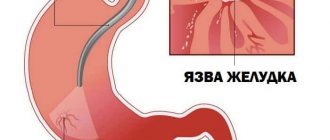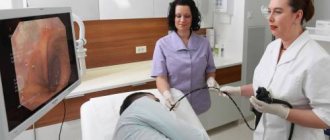Hematometra: what is it and what is the cause of the condition
The internal female genital organs are represented by the appendages, the body and cervix, and the vagina. They are all connected to each other. The uterus is a smooth muscle reproductive organ consisting of a body and a cervix. The latter is partially located in the vagina. The cervix has an external os (from the vagina) and an internal os (closer to the uterine cavity). These places have a special structure with a physiological narrowing of the channel. This is a “natural defense” against infection from entering the uterine cavity from the outside. Menstrual blood is the exfoliated surface layer of the endometrium mixed with blood. These secretions must move from the uterine cavity to the outside. The process occurs passively under the influence of gravity, as well as as a result of contraction of the myometrium. Lead to the hematometer:
- disturbance of contractile activity of the uterus - usually after childbirth, curettage;
- obstruction at the level of the internal or external pharynx - with spasm, tumor, intrauterine adhesions.
ICD-10 code for hematometers is N 85.7. It belongs to the category of non-inflammatory diseases of the uterine body. Usually, you have to deal with a hematometer after performing medical abortions, curettage for a non-developing pregnancy, as well as in the postpartum period.
Clinical manifestations
The main symptoms of hematometra:
- A sharp decrease or complete cessation of bleeding in the first days of menstruation after an instrumental or medical abortion, therapeutic and diagnostic curettage, in the early postpartum period or after a cesarean section (reduction or cessation of lochia discharge), etc.
- Absence or very scanty first menstrual flow in girls (with abnormal development of the genital organs).
- Feelings of heaviness in the lower abdomen (in the suprapubic region).
- Periodic cramping pain in the lower abdomen, which radiates to the lumbar region, sacrum and coccyx. Such pain becomes more intense with fast walking and physical activity.
- There may be a more frequent urge to urinate.
- An increase in the timing of the decrease in the size of the uterus (subinvolution) or, conversely, its increase after childbirth or cesarean section, pain on palpation and attempted displacement.
- An increase in body temperature and a deterioration in general condition - moderate weakness, chills (more often in the case of an infection), a feeling of malaise and weakness.
- Dizziness, severe weakness, palpitations, nausea - in cases of a significant volume of hematoma and its continued growth.
Very often, many subjective signs of hematometra are slightly expressed or absent altogether. Diagnosis of pathology is based on a combination of anamnestic data, the results of a gynecological examination and instrumental studies.
An external examination may reveal an enlarged, doughy, painful uterus, a discrepancy between its size and the postpartum period, and possible swelling of the perineum or only the labia majora and minora.
During a gynecological examination, the following may be detected:
- painful examination;
- congenital or acquired atresia of the hymen, a transverse septum of the upper third of the vagina, which take on the appearance of a protruding membrane through which a tumor-like formation (blood) of cyanotic color is visible; in some cases (with a large amount of blood), even “bulging” of the entire perineum is possible;
- cyanosis and swelling of the mucous membrane of the vagina and cervix, the presence of tumors and cysts;
- a spasmodic cervix and a narrowed external opening of the cervical canal with a slight release of blood from it or its complete absence after an abortion, spontaneous miscarriage or on the days of menstruation;
- parts of the fetus or membranes, a large blood clot after an abortion or miscarriage;
- lack of blood on days corresponding to menstruation, in the presence of an intrauterine device;
- the absence of lochia or its insignificant volume, inappropriate for the period of the postpartum period;
- discharge of blood through a catheter inserted through the cervical canal into the uterine cavity for diagnostic purposes;
- “testy” consistency of the uterus and pain upon palpation or displacement during bimanual examination and other symptoms.
Hematometra can be most reliably diagnosed by ultrasound or by hysteroscopy (in severe cases). The latter allows for simultaneous treatment procedures. The main echo signs of blood retention in the uterus are the presence of fluid in it and an increase in the volume of its cavity. The guideline is a 3-5 mm excess of the normal anteroposterior size. If there is blood in the fallopian tubes, their thickening is determined.
In addition, ultrasound can often diagnose the cause of blood retention - a decrease in the diameter of the internal and/or external pharynx, submucosal myoma, intrauterine synechiae, congenital anomalies, etc.
When does it occur in girls?
Hematometra can occur even in girls who are not sexually active. The reasons are related to malformations of the genital organs or anomalies in the structure:
- aplasia or atresia of the vagina - partial or complete underdevelopment of the vagina, its fusion in some area, associated with intrauterine developmental disorders;
- hymenal atresia - the presence of a dense hymen without a physiological opening for the exit of menstrual blood;
- additional horn - pathology occurs if the uterus has a rudimentary horn;
- rudimentary uterus - in addition to the normal structure, there is an additional horn or body of the uterus, not connected with the external environment of the vagina.
Hematometra occurs with the onset of puberty and cyclic processes in the endometrium. The greatest concerns arise during menstruation. In the case of hymenal atresia, there is a complete absence of bloody discharge or its spotting nature.
Symptoms
The following signs of hematometra are characteristic:
- pain in the lower abdomen - periodic (every three to four weeks), nagging, does not go away when taking analgesics and antispasmodics, can be aching or cramping in nature;
- high temperature, dizziness, nausea - during attacks;
- painful urination - or difficulty defecating;
- purulent discharge - with the addition of inflammation and fistulas.
Hematome pain, which is not relieved by taking pills, seriously affects the child’s psyche and can even lead to suicidal thoughts. The task of parents is not to leave teenagers unattended and to seek medical help in a timely manner.
Preventive measures
In order to avoid having to resort to treatment for hematometra after childbirth, curettage, etc., it is necessary to prevent this disease. This can be done through:
- regular examinations by a gynecologist not only after reaching reproductive age;
- compliance with personal hygiene rules;
- promptly treat pathologies of the pelvic organs, monitor any manipulations inside the uterus, and manage childbirth;
- A good way to prevent postpartum hematometra is to breastfeed the baby, urinate frequently, and apply ice to the abdomen.
To eliminate risks as much as possible, it is, of course, better to avoid abortions.
Did you know? In India and China, there are laws prohibiting finding out the sex of a child before birth. The reason for the introduction of such bills was the huge number of abortions associated with the reluctance of married couples to give birth to a daughter, since, for cultural and economic reasons, in these countries the birth of a boy is more prestigious and desirable.
https://youtu.be/MmYbKqlD3Xg
Any disease of the female reproductive system is fraught with unpleasant consequences if you do not consult a doctor in time. This disease can lead to infertility, the need to remove the uterus, or even blood poisoning, so it is important to adhere to prevention methods and treat hematometra in a timely manner. The main thing is to visit a gynecologist regularly (once every six months) and monitor the regularity of the menstrual cycle and the nature of the discharge.
Health Deviations and pathologies Diseases Uterus
After childbirth
Hematometra after childbirth is a serious danger. The uterus at this time is large and can accommodate an impressive amount of blood - up to 1 liter or more. Essentially, this is bleeding from the uterine cavity with an accumulation of blood inside - there are no external signs of pathology, which leads to late diagnosis and more complications.
A woman may make the following complaints:
- heaviness and pain in the lower abdomen;
- weakness, dizziness;
- cardiopalmus;
- a small amount of discharge from the genital tract.
The cause of postpartum hematometra is cervical spasm and atony of the uterine body. As a result, a large amount of blood is released through the gaping endometrial vessels, but the “closed” neck prevents it from coming out. In this case, remnants of the membranes are often found, which is why the condition is called lochiometra.
Postpartum hematometra occurs more often in women:
- after caesarean section;
- against the background of severe gestosis at the end of pregnancy;
- with a large fruit;
- with polyhydramnios on the eve of childbirth;
- during multiple pregnancy;
- during interventions inside the uterine cavity.
Blood loss with a hematometer after childbirth can reach 1 liter or more. This forces an urgent transfusion and curettage of the uterine cavity to evacuate the contents. In the future, serious conservative treatment is necessary to prevent other complications.
Will it happen again in the next pregnancy?
Difficult recovery after blood loss and the need for a donor's blood transfusion frighten the woman: what if everything happens again during the next pregnancy? But such a possibility exists only in cases where the cause of poor uterine contractions is associated with individual characteristics of the structure and functioning of tissues. If hematometra developed against the background of provoking factors (for example, multiple pregnancy or polyhydramnios), then in their absence the risk of such a complication is minimal.
However, a history of hematometra always alarms doctors; many prefer in such cases to carry out preventive measures during the next birth. For example, dilation of the cervical canal during a cesarean section or curettage of the uterine cavity immediately after a natural birth.
Hematometer
This is a painful condition that develops due to difficulty or impossibility of blood flow from the uterine cavity. A characteristic sign of it is a sudden cessation of blood flow during menstruation or in the postoperative period. This pathology is diagnosed quite rarely in gynecological practice, mainly in young girls.
The development of the pathological process is associated with:
Practice shows that in most cases this pathology develops as a complication after childbirth. Hematometra takes second place after abortion and surgical interventions.
This pathology is diagnosed in most cases only at the stage of bacterial infection of the uterine tissue and the development of pyometra, that is, purulent inflammation. Which, in turn, complicates her treatment and significantly worsens the patient’s condition.
Hematometra can occur independently or be combined with hematocolpos (collection of blood in the vagina) and collection of blood in the fallopian tubes (hematosalpinx).
Signs
The main factor that should alert a woman is a sudden cessation of bleeding. With any bleeding, the process slowly fades away. Otherwise, you should contact a gynecologist as soon as possible. Because the strength of symptoms directly depends on:
- From the volume of secretions accumulated in the uterine cavity.
- Duration of hematometra formation.
- The causes and factors that gave rise to it.
- Patient's age.
For example, in adolescence, patients suffering from cervical stenosis develop secondary or false amenorrhea. There is no vaginal discharge during the menstrual period; the girl notes:
- Discomfort in the lower abdomen and heaviness.
- Periodic cramp-like pain.
The intensity of the pain syndrome varies from barely noticeable sensations to attacks, which in intensity can be compared to the onset of labor pains.
With the development of pathology in women, a deterioration in the general condition is observed, provoked by internal bleeding:
- Severe weakness.
- Tachycardia.
- Decreased blood pressure.
- Lightheadedness and dizziness.
- Visual symptoms (appearance of “floaters” in the field of vision).
- Fainting.
- Anemia.
- Pressure and pain in the lower abdomen.
Blood is a fertile environment for the development of bacteria. Pyometra is a frequent companion of hematometra that is not treated in time.
The hematometer also creates good conditions for other inflammatory diseases of the uterus: endometritis or combined inflammation of the myometrium and endometrium (metroendometritis). Untreated hematometra can lead to the formation of Coover's uterus, sepsis or peritonitis. The consequence of untimely evacuation of blood accumulation quite often becomes infertility.
Causes
The main reason for the lack of evacuation of blood from the uterine cavity is, as mentioned above, the appearance of obstacles in its path and a violation of the contractile activity of the myometrium. The risk of developing this pathology doubles when both of these causes are present simultaneously.
Taking into account all possible factors, it is customary to distinguish 4 main groups of reasons:
- Childbirth.
- Interventions on the uterus.
- Obstruction (formation of obstructions) of the genital tract.
- Cervix stenosis.
Obstruction can be caused by mechanical compression from the outside or anatomical defects of the genital tract. That is, be organic or functional in nature. Organic pathology includes:
- Atresia (fusion of the walls) of the vagina.
- Formation of the intrauterine septum.
- Asherman's syndrome (intrauterine adhesions or synechiae). The formation of synechiae leads to partial and sometimes complete obliteration (fusion) of the vagina.
If these anomalies were not diagnosed and corrected in childhood, then at the age of puberty and the onset of menstrual bleeding, they become the cause of hematomeres.
Organic causes include neoplasms in the uterus itself or along the path of blood flow, that is, in the cervix. They create a physical obstacle to the movement of the contents of the uterus after medical abortion, separate curettage performed for diagnostic purposes (RDV). Such formations include:
The outflow of blood from the uterine cavity can be obstructed by obstruction (blockage) of the internal os of the organ. This is possible if a fairly large blood clot, part of the placenta, or a fragment of a fetus destroyed during the abortion process is retained in the pharynx.
The formation of hematometra may be associated with cicatricial deformation of the uterine cervix, which causes its narrowing. Scars form after radiation therapy or traumatic surgery.
Cervix spasm is considered as functional causes:
- After artificial termination of pregnancy.
- After LDV (curettage performed for diagnostic and therapeutic purposes).
A disturbance in the outflow of bloody contents from the uterus, which develops within a few weeks after childbirth, is called lochiometra because postpartum bleeding is called lochia. This postpartum complication is most often provoked by:
- Hypo- or atony of the myometrium.
- Shock caused by large blood loss.
- Inactive labor.
- Manual separation of the placenta.
- Excessive stretching of the myometrium by a large fetus.
- Overstretching of the uterus due to multiple pregnancy.
- Scar changes on the uterus or its cervix, resulting from tissue ruptures as a result of childbirth.
After an abortion, miscarriage, frozen pregnancy
Hematometra is a common occurrence after diagnostic curettage, medical and surgical abortion, vacuum aspiration, including for miscarriage or frozen pregnancy. The reasons are as follows:
- spasm of the cervical canal;
- mechanical obstacle at the level of the internal pharynx.
The symptoms of hematometra in this case are not so striking. Sometimes a woman is only bothered by minor nagging pain in the lower abdomen, which she associates with a recent manipulation. You may also experience:
- increase in body temperature - with the addition of inflammation;
- severe spasmodic pain in the lower abdomen;
- abrupt cessation of discharge - immediately after manipulation.
When can you plan to conceive?
An attempt at an unsuccessful pregnancy overshadows the woman until the moment when the couple is able to conceive and carry a baby again. Planning, regardless of the number of curettages performed, can be done no earlier than three months later. If the hematometra was accompanied by other complications, the interval can be increased to six months or more. In each case, the time for successful pregnancy planning after hematometra should be considered individually together with the attending physician.
For three to six months, birth control pills are recommended. This will avoid pregnancy, which will allow the endometrium of the uterus to recover. Sex can be resumed immediately after bleeding and pain stop.
ethnoscience
This is not a disease for which traditional treatment will help. At most, a woman can relieve symptoms while undergoing drug therapy. Methods:
Video: Hematometra: what is it, why is it dangerous and how to treat?>
This is interesting to read
Endometritis as a cause of infertility
More about antisperm antibodies
Hematologist: who is he, what diseases does he treat, contacting him before and during pregnancy
Acute and chronic cervicitis
Against the background of normal menstruation
Hematometra can occur in seemingly healthy women. The accumulation of blood clots occurs during menstruation when there is an obstruction to the outflow of the contents of the uterine cavity. This can be caused by:
- rigidity of the tissues of the cervical canal - after numerous curettages, including abortions;
- adhesions and adhesions - in the area of the internal os of the cervix;
- polyp - cervical canal;
- submucous fibroids - located near the cervix;
- intrauterine device - and its displacement;
- swelling of the tissues of the cervical canal - due to inflammation, allergies to drugs, contraceptives.
Symptoms
Symptoms of formed hematomas against the background of menstruation force a woman to seek medical help due to intense pain. They can be cutting, pulling, or cramping in nature. Pain occurs due to increased pressure inside the uterine cavity and impact on the internal os. Additionally, urination may become more frequent due to the effect on the bladder. Or the urge to defecate appears when the uterus is retroflexed (positioned backwards).
An important diagnostic criterion for confirming hematometra in this case is the sudden cessation of menstrual flow. After a few hours, the woman notices the appearance of pain.
In menopause
Hematometra after the end of menstruation in a woman (postmenopausal) is associated with diagnostic intrauterine procedures or benign or malignant tumors. This should be treated with caution and diagnostic searches should be expanded.
Symptoms of hematometra may be absent or minimal. It can be confused with a serozometer (in the latter case, clear liquid accumulates in the uterus). A clear clinical picture is typical when inflammation or heavy bleeding occurs.
Diagnostic methods
To diagnose a hematometra, a number of procedures and manipulations are performed. Among the main ones, the following stand out:
- the doctor's consultation. The specialist listens to the woman’s complaints and learns about the time of occurrence of changes in the body and the characteristics of the clinical picture;
- visual gynecological examination, which may be accompanied by a bimanual examination;
- Ultrasound;
- hysteroscopy;
- taking a smear from the vagina, cervix and urethra.
During the examination, the consistency, size of the uterus, and its sensitivity to pain are determined. Swelling of the external genitalia is possible.
Therapeutic tactics
Suspicion of a hematometra requires a serious examination and often immediate action by a doctor. This is especially true for postpartum complications. The use of folk remedies is fraught with serious consequences for the body, including the acquisition of chronic endometritis. The algorithm of actions is presented in the table.
Table - Diagnosis and treatment of hematomas
| Diagnostics | Conservative treatment | Surgical treatment |
| — Examination on a gynecological chair; — Ultrasound of the pelvis; - CT or MRI (if a malformation of the genital organs is suspected) | — Antispasmodics in injections, tablets or droppers; — antibacterial therapy to prevent inflammation; - contracting drugs; - painkillers; - blood transfusion (for large blood loss after childbirth) | — Bougienage of the cervical canal; — removal of blood clots by curettage of the uterine cavity, vacuum aspiration; - hysteroresectoscopy (if polyps or submucous fibroids are suspected); — for malformations of the genital organs, operations are variable (from dissection of the hymen to vaginal plastic surgery, removal of the uterus and appendages) |
Indications for additional intervention (usually curettage - “cleaning”) with a hematometer:
- postpartum condition;
- suspicion of the remains of a fertilized egg after an abortion;
- polyps of the cervical canal of any size;
- hematometra in postmenopause;
- malformations of the genital organs.
With a slight expansion of the uterine cavity due to blood clots, conservative therapy is prescribed. If it is ineffective (the hematometra does not go away after a day or two), it is necessary to remove the contents mechanically.
Recommendations after treatment
Freeing the uterine cavity from pathological contents does not mean the end of treatment. Recovery of the body will take at least another three to four weeks. During this period it is recommended:
- limit or refuse sexual contacts;
- do not visit baths, saunas, swimming pools;
- strictly follow the doctor's instructions;
- protect yourself from pregnancy (at least three months).
Hematometra is a symptom of many gynecological diseases. It is most dangerous when detected in girls during puberty, as it is often associated with serious malformations of the genital organs. Treatment for hematometra depends on the cause of blood accumulation in the uterine cavity. Curettage of the uterine cavity is not always necessary, reviews from women confirm this.
Prevention
Prevention of hematometra involves regular monitoring of the woman by a gynecologist. For the first time, a girl should be examined by a specialist even before the onset of puberty - this allows for timely diagnosis of possible anomalies in the development of the genital tract. If a girl has not started menstruating before the age of 16, it is necessary to conduct an in-depth gynecological examination.
Other methods of preventing hematomas are:
- pregnancy planning;
- use of modern methods of contraception that avoid induced abortions;
- rational management of pregnancy, childbirth and the postpartum period;
- early attachment of the baby to the breast and breastfeeding (this promotes the production of oxytocin, which stimulates uterine contractions in the postpartum period);
- control over timely emptying of the bladder in the postpartum period.











